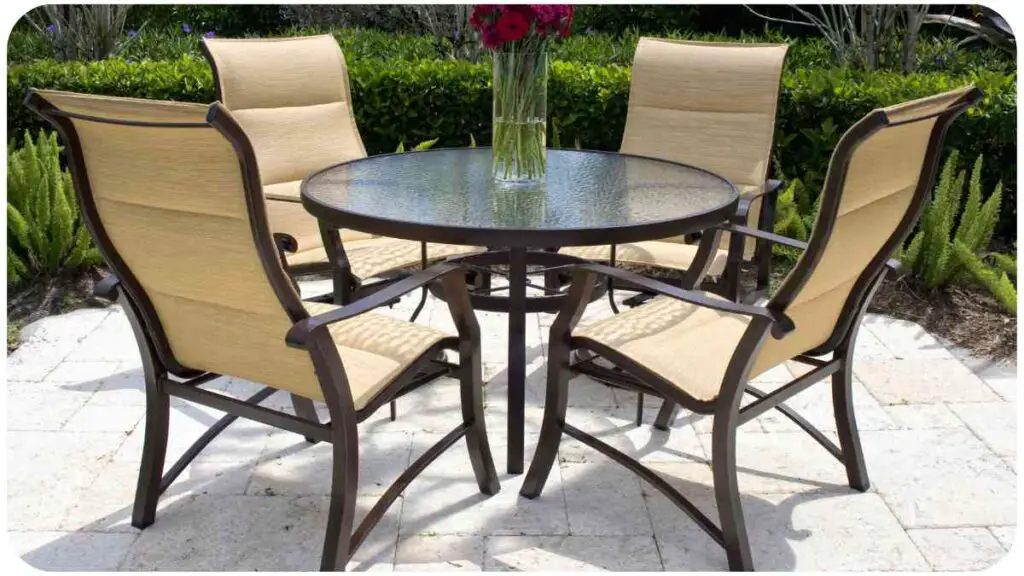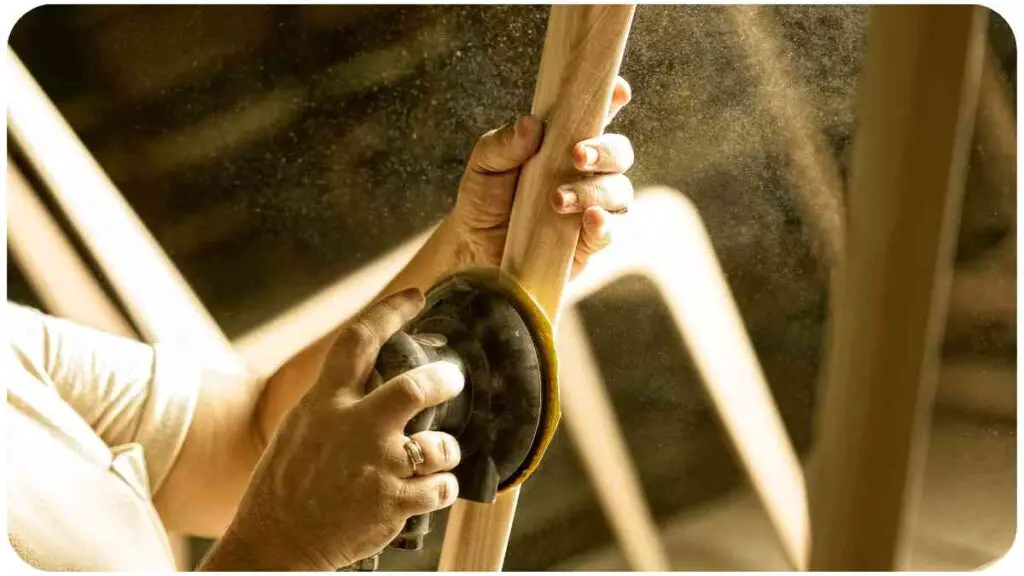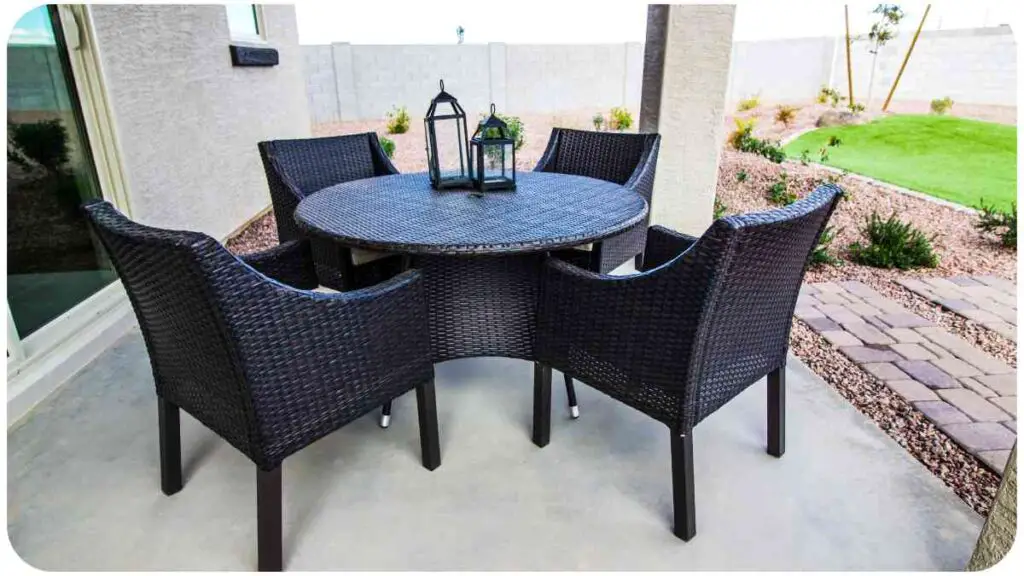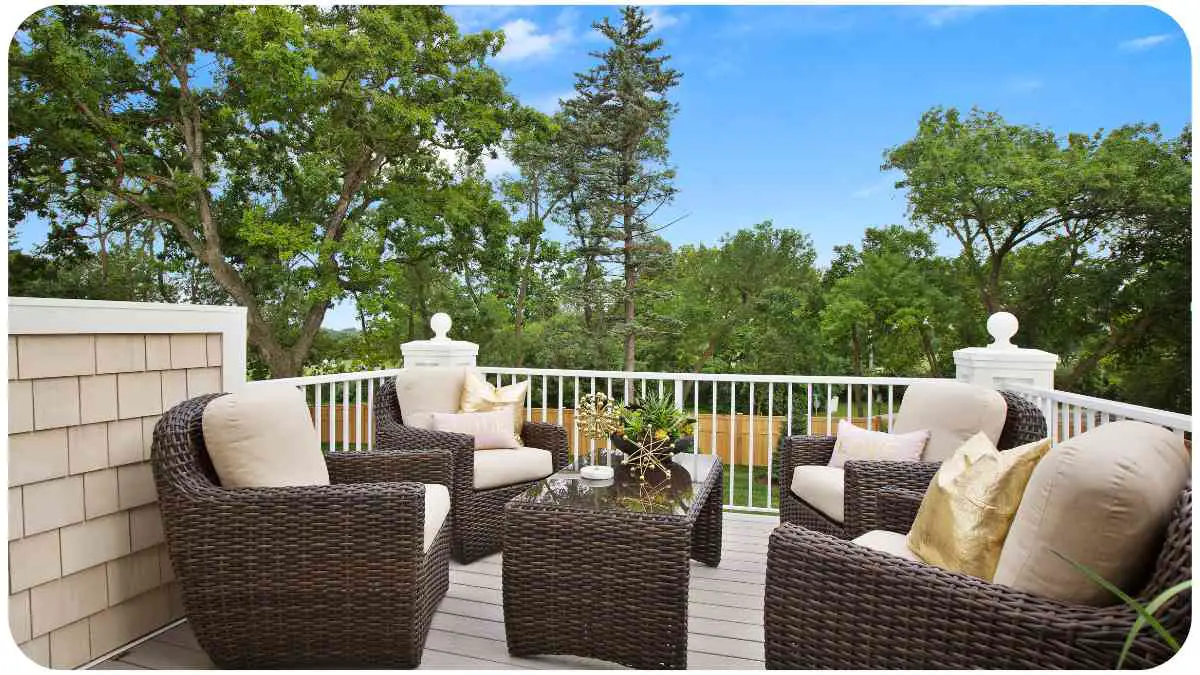Outdoor furniture can withstand a lot, but torn fabric is an inevitable woe. Whether it’s a cherished patio chair or a weathered umbrella, learning how to repair torn outdoor furniture fabric can extend the life of your favorite pieces.
In this DIY guide, we’ll explore the materials, tools, and step-by-step processes to mend those unsightly tears. Let’s dive in!
| Takeaways |
|---|
| 1. Know Your Fabric: Understand the type of outdoor fabric for effective repairs. |
| 2. Essential Tools: Gather a repair kit, fabric scissors, and cleaning supplies for a well-equipped workspace. |
| 3. Step-by-Step Process: Follow a systematic repair process, including cleaning, patching, and color blending. |
| 4. DIY vs Professional Repair: Weigh the cost, time, and skill factors before deciding on the repair approach. |
| 5. Preventive Maintenance: Regular cleaning, UV protection, and proper storage can extend furniture lifespan. |
| 6. Common Mistakes to Avoid: Choose the right repair materials, follow instructions, and avoid rushing the process. |
| 7. Expert Tips: Gain insights from textile experts and furniture restoration professionals for successful repairs. |
| 8. Case Studies: Learn from real-life examples of successful DIY repairs on patio chairs, umbrellas, and benches. |
| 9. Reader Q&A: Address common reader queries and troubleshoot challenges encountered during repairs. |
| 10. Environmental Impact: Consider the sustainability of DIY repairs and recycling options for old fabrics. |
2. Understanding the Types of Outdoor Furniture Fabric

2.1 Common Materials
| Fabric Type | Characteristics |
|---|---|
| Polyester | Durable, resistant to fading |
| Canvas | Sturdy, ideal for heavy-duty furniture |
| Mesh | Breathable, suitable for outdoor seating |
2.2 Durability Factors
| Factor | Impact on Durability |
|---|---|
| UV Resistance | Protects fabric from sun damage |
| Water Repellency | Prevents water-induced damage |
| Mildew Resistance | Guards against fungal growth |
Understanding the fabric types and their durability factors is crucial for effective repairs. Next, let’s delve into assessing the damage.
Outdoor faucets often need attention. If you’re dealing with leaking faucets, this comprehensive guide provides step-by-step instructions to help you fix the issue and maintain a functional outdoor space.
3. Assessing the Damage
3.1 Identifying Tears and Frays
| Damage Type | Description |
|---|---|
| Tear | Long, straight rip in the fabric |
| Fray | Unraveled or worn-out edges |
3.2 Determining Fabric Compatibility
| Fabric Type | Repair Method |
|---|---|
| Polyester | Adhesive patch |
| Canvas | Sewing or patching |
| Mesh | Stitching or patching |
Identifying the damage type and fabric compatibility sets the stage for effective repairs. Now, let’s gather the essential tools and materials.
4. Essential Tools and Materials
4.1 Repair Kits Overview
| Kit Type | Inclusions |
|---|---|
| Adhesive Patch | Adhesive, fabric patch |
| Sewing Kit | Needles, thread, fabric swatches |
| UV Protector | Spray or liquid form |
4.2 Additional Supplies
| Supplies | Purpose |
|---|---|
| Fabric Scissors | Cutting and shaping |
| Fabric Markers | Color matching and blending |
| Cleaning Solution | Preparing the fabric surface |
Now that we have our tools ready, let’s jump into the step-by-step repair process.
Tired of an uneven lawn? Follow these lawn-fixing steps for a smoother, more attractive outdoor area. Learn effective techniques to address unevenness and enhance the overall appeal of your lawn.
5. Step-by-Step Repair Process

5.1 Preparing the Work Area
Creating a clean and organized workspace is essential for a successful repair. Clear any debris and ensure good lighting.
5.2 Cleaning the Fabric
Use a suitable cleaning solution to remove dirt and debris from the torn area. This ensures a strong bond when applying the patch or adhesive.
5.3 Applying Patch or Adhesive
Follow the instructions on the repair kit. Apply the adhesive or affix the patch securely over the tear. Press firmly and allow sufficient drying time.
Effective drainage is crucial for a healthy garden. Discover common issues and fixes to ensure optimal water management in your garden. Proper drainage solutions contribute to healthier plants and a more vibrant outdoor space.
5.4 Blending Colors and Patterns
For a seamless repair, use fabric markers to match colors and patterns. This step adds a professional touch to your DIY fix.
5.5 Final Touches
Inspect the repaired area for any loose ends or irregularities. Trim excess fabric and ensure the repair blends seamlessly with the rest of the furniture.
Continue for more detailed steps and insights into DIY vs professional repairs, preventive maintenance tips, common mistakes to avoid, and expert tips and tricks.
6. DIY vs Professional Repair: Pros and Cons
6.1 Cost Comparison
| Aspect | DIY Repair | Professional Repair |
|---|---|---|
| Cost | Affordable, minimal investment in kits | Higher upfront cost, labor charges |
| Time | Variable, depends on skill level | Quick turnaround by professionals |
| Skill Requirement | Moderate DIY skills required | Expertise and experience |
| Customization | High level of personalization | Standardized approach |
6.2 Time and Skill Considerations
| Consideration | DIY Repair | Professional Repair |
|---|---|---|
| Learning Curve | Learning as you go, trial and error | Specialized training and expertise |
| Time Investment | Potentially longer repair time | Efficient and time-saving |
| Risk of Errors | Higher risk of mistakes | Minimal room for errors |
| Skill Development | Opportunity to enhance DIY skills | Leave it to the professionals |
6.3 When to Seek Professional Help
| Situation | DIY Repair Recommendation | Professional Repair Recommendation |
|---|---|---|
| Extensive Damage | Limited DIY capability for extensive tears | Seek professional assessment |
| High-Value Furniture | Valuable pieces may warrant professional touch | Professional restoration advisable |
| Lack of Time or Skill | Limited time or skill for DIY repairs | Efficient, quick solution by experts |
7. Preventive Maintenance Tips
Cracks in your patio can be unsightly and hazardous. This step-by-step guide offers valuable insights on identifying and repairing patio cracks, enhancing the durability and aesthetics of your outdoor living area.
7.1 Regular Cleaning Routine
| Cleaning Schedule | Recommendations |
|---|---|
| Monthly | Mild cleaning solution to remove dust and prevent staining |
| Seasonal | Deep clean to remove accumulated dirt and grime |
| Yearly | UV protectant application to prevent sun damage |
7.2 UV Protection Measures
| Protection Method | Application |
|---|---|
| UV-Resistant Covers | Use covers when furniture is not in use |
| UV Spray | Apply UV protection spray periodically |
| Shaded Placement | Position furniture in shaded areas to reduce sun exposure |
7.3 Seasonal Storage Guidelines
| Storage Tips | Best Practices |
|---|---|
| Clean and Dry | Ensure furniture is clean and completely dry |
| Cover with Fabric | Use breathable fabric covers for protection |
| Elevate from Ground | Avoid direct contact with the ground to prevent moisture damage |
These preventive measures can significantly extend the life of outdoor furniture. Now, let’s discuss common mistakes to avoid when undertaking repairs.
8. Common Mistakes to Avoid

8.1 Using the Wrong Repair Materials
| Mistake | Consequence |
|---|---|
| Incorrect Adhesive | Weak bond, ineffective repair |
| Mismatched Fabric | Unappealing, noticeable patch |
| Improper Cleaning | Adhesive may not adhere properly |
8.2 Ignoring Manufacturer Guidelines
| Mistake | Consequence |
|---|---|
| Not Following Instructions | Ineffective repair, potential damage |
| Voiding Warranty | Disregarding guidelines may nullify warranties |
| Using Non-Approved Materials | Risk of further damage and deterioration |
8.3 Rushing the Repair Process
| Mistake | Consequence |
|---|---|
| Incomplete Drying | Weak bond, patch may not hold up |
| Skipping Cleaning Steps | Adhesive may not adhere properly |
| Neglecting Color Matching | Unattractive repair, noticeable color differences |
Avoiding these mistakes is crucial for a successful repair. In the next section, we’ll explore ways to extend the overall lifespan of outdoor furniture.
Continue reading for tips on quality fabric selection, proper covering techniques, yearly inspection, and maintenance to ensure the longevity of your cherished pieces.
Gardeners often face plant-related challenges. Explore methods for identifying and treating fungal diseases in plants to safeguard your garden. This comprehensive guide empowers you to maintain a healthy and thriving outdoor environment.
9. Extending the Lifespan of Outdoor Furniture
9.1 Quality Fabric Selection
| Consideration | Recommendations |
|---|---|
| UV Resistance | Choose fabrics with high UV resistance for prolonged sun exposure |
| Water Repellency | Opt for materials with water repellent properties to prevent mold and mildew |
| Durability | Prioritize fabrics known for durability and longevity |
| Easy Maintenance | Select fabrics that are easy to clean and maintain |
9.2 Proper Covering Techniques
| Covering Tips | Best Practices |
|---|---|
| Breathable Covers | Choose covers made of breathable materials to prevent condensation |
| Snug Fit | Ensure covers fit snugly to prevent wind or water from entering |
| Secure Fastening | Use straps or ties to secure covers during adverse weather conditions |
9.3 Yearly Inspection and Maintenance
| Inspection Steps | Recommendations |
|---|---|
| Check Seams | Inspect seams for signs of wear or unraveling |
| Tighten Fastenings | Ensure all screws, bolts, and fastenings are tight |
| Clean Thoroughly | Perform a thorough cleaning to remove dirt and debris |
| Assess Cushions | Inspect and replace cushions if signs of deterioration are present |
By implementing these practices, you can significantly prolong the life of your outdoor furniture. In the following section, we’ll explore real-life case studies showcasing successful DIY repairs.
10. Case Studies: Successful DIY Repairs
10.1 Patio Chair Tear Recovery
| Situation | DIY Approach |
|---|---|
| Tear in Fabric | Applied adhesive patch, blended colors for seamless repair |
| Result | Chair fully restored, with the repair virtually invisible |
10.2 Reviving a Tattered Umbrella
| Situation | DIY Approach |
|---|---|
| Multiple Tears | Used a combination of adhesive patches and sewing for a comprehensive fix |
| Result | Umbrella regained its structural integrity and aesthetic appeal |
10.3 Transforming an Aging Bench
| Situation | DIY Approach |
|---|---|
| Frayed Edges | Employed sewing techniques, reinforced weak areas for enhanced durability |
| Result | Bench not only repaired but also enhanced in strength and appearance |
These case studies demonstrate the effectiveness of DIY repairs in restoring outdoor furniture. Now, let’s gain insights from textile experts and furniture restoration professionals.
11. Expert Tips and Tricks
11.1 Insights from Textile Experts
| Expert Recommendation | Key Takeaway |
|---|---|
| Use High-Quality Materials | Investing in premium fabrics pays off in longevity and durability |
| Regular Inspection and Maintenance | Detecting issues early prevents extensive damage |
| Upholstery Protectors | Applying protectors helps guard against spills and stains |
11.2 Advice from Furniture Restoration Pros
| Professional Advice | Key Recommendations |
|---|---|
| Know Your Furniture | Understand the materials and construction of your furniture for effective repairs |
| Matching Colors | Master color matching techniques for seamless and aesthetically pleasing repairs |
| DIY-Friendly Products | Choose repair kits and materials designed for easy use by DIY enthusiasts |
Next, we’ll address common reader questions and troubleshooting challenges related to outdoor furniture repairs.
Continue reading for valuable insights and practical advice to address reader queries and challenges in the repair process.
12. Reader Q&A
12.1 Addressing Common Reader Queries
Q: Can I use a regular fabric patch for outdoor furniture repairs?
A: While regular fabric patches may provide a temporary fix, it’s advisable to use patches specifically designed for outdoor furniture. These are often treated for UV resistance and water repellency, ensuring a more durable and long-lasting repair.
Q: How do I prevent color fading after repairing outdoor furniture fabric?
A: To prevent color fading, use fabric markers specifically formulated for outdoor use. Additionally, consider applying a UV protector to shield the repaired area from sun damage and maintain vibrant colors.
Q: Can I repair mesh fabric on outdoor chairs myself?
A: Yes, you can repair mesh fabric on outdoor chairs using patch kits designed for mesh materials. Follow the instructions carefully, ensuring a secure and seamless repair.
12.2 Troubleshooting Repair Challenges
Challenge: Adhesive not sticking well to the fabric.
Solution: Ensure the fabric is thoroughly cleaned and completely dry before applying the adhesive. Choosing an adhesive specifically formulated for outdoor fabrics can also improve bonding.
Challenge: Patch is noticeable after the repair.
Solution: Use fabric markers to blend the colors seamlessly. Take your time matching patterns and hues to achieve a repair that is virtually invisible.
Challenge: Tears reappear after a few uses.
Solution: Double-check the tear’s size and use an appropriate-sized patch. If tears persist, consider seeking professional advice, as there may be underlying issues with the fabric.
In the next section, let’s explore the environmental impact of repairing versus replacing outdoor furniture and sustainable options for old fabrics.
13. Environmental Impact of Repairing vs Replacing
13.1 Sustainability of DIY Repairs
Repairing outdoor furniture is a sustainable practice that reduces waste and lessens the environmental impact of discarded items. By extending the lifespan of your furniture through repairs, you contribute to a more eco-friendly approach to consumption.
13.2 Recycling Options for Old Fabrics
If outdoor furniture fabric is beyond repair, explore recycling options. Some communities have textile recycling programs, while others may accept old fabrics in recycling centers. Check local guidelines to ensure responsible disposal.
In the concluding section, we’ll recap the key points discussed in this DIY guide and provide additional resources for further information.
Continue reading for a comprehensive conclusion and additional resources to help readers delve deeper into outdoor furniture repair and maintenance.
14. Conclusion
Repairing torn outdoor furniture fabric is a rewarding and eco-friendly endeavor that can breathe new life into your cherished pieces. By following the comprehensive DIY guide provided, you’ve learned about the different types of outdoor fabrics, assessed damage, gathered essential tools, and embarked on a step-by-step repair process.
We explored the pros and cons of DIY versus professional repairs, preventive maintenance tips, common mistakes to avoid, and received valuable insights from experts. Real-life case studies showcased successful DIY repairs, and reader Q&A addressed common concerns.
Remember, regular inspection, proper maintenance, and quality fabric selection are essential for extending the lifespan of your outdoor furniture. Whether you opt for a DIY approach or seek professional help, the key is to act promptly and thoughtfully when damage occurs.
Further Reading
- Phifer: Upholstery Fabric for Reupholstering: Explore Phifer’s guide on choosing the right upholstery fabric for reupholstering outdoor furniture. Learn about fabric types, durability, and maintenance tips.
- HomeTalk: Replacing or Repairing Dry-Rotted Fabric on Outdoor Furniture: Join the HomeTalk community discussion on addressing dry-rotted fabric issues in outdoor furniture. Gain insights and advice from DIY enthusiasts who have tackled similar challenges.
- Trim That Weed: How to Repair Outdoor Furniture Fabric: Discover practical tips and step-by-step instructions on repairing outdoor furniture fabric. Trim That Weed provides a comprehensive guide for DIYers looking to revitalize their outdoor seating.
FAQs
How can I determine the type of outdoor furniture fabric?
To identify the fabric type, check manufacturer tags or conduct a burn test. Different materials have unique characteristics, such as burn smell and residue.
Is it possible to repair mesh fabric on outdoor chairs myself?
Yes, repairing mesh fabric is achievable with patch kits designed for mesh materials. Follow the provided instructions carefully for a successful repair.
What’s the importance of using UV-resistant covers for outdoor furniture?
UV-resistant covers protect furniture from sun damage, preventing color fading and deterioration. They are crucial for maintaining the longevity of outdoor fabrics.
Can I use regular fabric patches for outdoor furniture repairs?
While regular fabric patches may offer a temporary fix, it’s recommended to use patches specifically designed for outdoor furniture. These are treated for UV resistance and water repellency.
How do I prevent color fading after repairing outdoor furniture fabric?
Prevent color fading by using fabric markers formulated for outdoor use and applying a UV protector to shield the repaired area from sun damage.

Hi! My name is Hellen James, and I’m here to help you with your home-maintenance needs. Whether it’s building a better yard or just trying to fix a garden—I can show you how.


